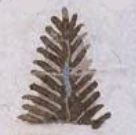tzontli (Osu1v)
This black-line drawing of the simplex glyph and notation comes from the Codex Osuna, folio 1 verso (Image 5). It appears to show a standing tree. Perhaps it is meant to be a pine tree, and the number of needles could approximate 400. It is not clear. A tzontli, besides being 400, is also a large hank of hair, almost impossible to count. This simplex glyph standing for a notation, however, does not look like human hair.
Stephanie Wood
quatrozs~.
cuatrocientos
Stephanie Wood
1551–1565
Jeff Haskett-Wood
números, cuatrocientos, pelos, árboles, notación

tzon(tli), the number 400, https://nahuatl.wired-humanities.org/content/tzontli
centzon(tli), 400, https://nahuatl.wired-humanities.org/content/centzontli
cen, the combining form for the number one, https://nahuatl.wired-humanities.org/content/cen-0
cuatrocientos
Stephanie Wood
Library of Congress Online Catalog and the World Digital Library, Osuna Codex, or Painting of the Governor, Mayors, and Rulers of Mexico (Pintura del Gobernador, Alcaldes y Regidores de México), https://www.loc.gov/resource/gdcwdl.wdl_07324/. The original is located in the Biblioteca Nacional de España.
"The Library of Congress is unaware of any copyright or other restrictions in the World Digital Library Collection. Absent any such restrictions, these materials are free to use and reuse." But please cite the Biblioteca Nacional de España and this Visual Lexicon of Aztec Hieroglyphs if you use any of these images here or refer to the content on this page, providing the URL.







